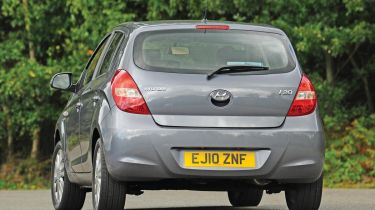Hyundai i20
Korean model is a huge hit, scoring on value and spec
ON the back of its Scrappage Scheme sales success, Hyundai is a big player in the small car market. The i20 was launched in 2009 and, as with its successful i10 city car stablemate, has been designed with European consumers very much in mind.
No surprise, then, that it has mainstream supermini looks.
Its shape more than hints at the Vauxhall Corsa’s, and while this won’t offend anyone, the car seems anonymous next to the sharply angled Mazda and distinctively rounded Swift.
With the longest wheelbase and widest body in this test, the Hyundai offers plenty of passenger space. The 295-litre boot is the biggest of the trio, and the rear seats split 60:40. There’s plenty of kit, too. Comfort models get Bluetooth, power-fold mirrors and steering wheel audio controls. Electric rear windows and curtain airbags are standard as well, but there is room for improvement on the inside. Although the i20 is well assembled and the dash layout straightforward, some of the interior plastics are below par, particularly on the door panels.
This is a shame, as it detracts from the great driving position. The Hyundai is the only model on test with a steering wheel that adjusts for both rake and reach. And while the amount of column movement is limited, the driver’s seat can also be raised or lowered.
Used - available now

2024 Audi
A3 Saloon
11,848 milesAutomaticPetrol1.5L
Cash £23,000
2019 Mercedes
GLC
53,377 milesAutomaticDiesel2.1L
Cash £18,987
2022 Nissan
Leaf
23,640 milesAutomaticElectric
Cash £10,300
2022 Peugeot
E-2008
53,032 milesAutomaticElectric
Cash £12,787Light controls make the car easy to drive, but the five-speed box doesn’t feel as precise as the sporty transmission in the Mazda. We’ve complained about the steering before, and it still has an artificial feel, which increases in weight heavily either side of the straight-ahead.
There’s less front-end grip in the Hyundai, so it doesn’t corner with the same verve as the Mazda, and it can’t match the Swift’s grown-up composure. Refinement at speed is decent, though, and while the 1.4-litre unit is coarse low down, it’s pretty refined at motorway speeds.
The unit is the biggest in our trio, and its advantage is obvious from behind the wheel. This was the only car tested in dry conditions, which helps explain its superiority from a standing start. But our in-gear assessments are telling: it covered 30-50mph in fourth in 9.3 seconds – more than half a second faster than its rivals.
There is a price to pay, and it comes at the tailpipe. The i20 emits 9g/km more CO2 than the Swift, although its 125g/km output is identical to the 2’s.
The aftersales package stands out from the other models’, though. Hyundai’s five-year, unlimited-mileage warranty makes the supermini an attractive ownership prospect.
But does this, as well as the car’s space and comfort, help to offset the limited driver appeal and questionable style, and take the i20 to the top of the tree?
Details
Chart position: 3
WHY: Good-value pricing made the i20 one of the stars of the Scrappage Scheme. Add a five-year warranty, spacious cabin and extensive list of standard equipment, and you can understand why the Korean car is so enormously popular.







